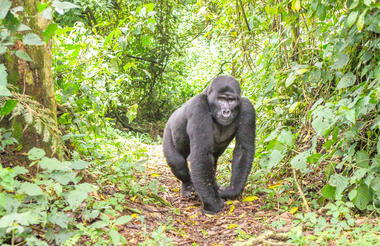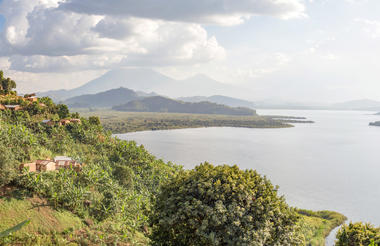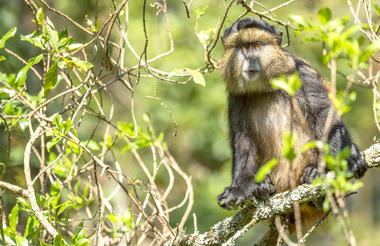Early morning after breakfast, your guide will brief you about the journey and later transfer you to Bwindi Impenetrable Forest National Park which is Located in southwestern Uganda, the Bwindi Impenetrable Forest is said to be Africa’s oldest rainforest. It is world-renowned for its excellent gorilla-sighting opportunities. The rugged landscape features dense jungle, cascading waterfalls, sparkling mountain streams, deep valleys and steep ridges. This untouched forest has been declared a UNESCO World Heritage Site because of its breathtaking natural beauty and unique ecological significance. Aside from the amazing gorilla interactions, there are other drawcards such as a network of forest walks, over 340 species of bird to spot and a variety of butterflies. Don’t miss the opportunity to explore the spectacular Virunga Volcanoes.
Alternatively, you may opt to fly to Bwindi via Kisoro Airstrip at a supplement of $353 per person for one way, the return flight is $550 per person .
You will stop for lunch at the equator for lunch and you will be able to stand in 2 hemispheres at the same time. You will be able to take some photos while at the equator.You will arrive at the lodge in time for dinner



Details on what to pack for gorilla tracking in Uganda and Rwanda
When travelling to foreign destinations it is always respectful to dress modestly and we suggest the emphasis is on comfortable clothing. It is often warm on the plains and at lower altitudes but cold in the hilly and mountainous areas of Uganda and Rwanda; a rain jacket, fleece and good quality walking shoes/boots are essential.
When trekking the gorillas and chimpanzees we recommended wearing sturdy clothing to help protect against scratches, i.e. long sleeve shirt, trousers and a good pair of lightweight walking boots. Protective leather gloves or gardening gloves are also useful, as well as a pair of gaiters.
As the temperature is variable and weather conditions can change; we also recommend taking a fleece or light jumper (layers of clothing are best especially with moisture-wicking undergarments) and lightweight breathable waterproof jacket/trousers or poncho. A small backpack is useful to carry your water, pack lunch, camera and binoculars. Walking sticks are available at the park head quarters as are porters (it is worth taking a porter as it provides local people with employment and they will give you a helping hand on any steep terrain).
Whilst on safari neutral coloured, loose fitting and relaxed clothing is the most appropriate. Most hotels and lodges have laundry services, so an excessive amount of clothing should be unnecessary. Please note that most hotels and lodges hand wash clothing.
Khaki / natural coloured clothing for safaris / trekking
- 1 – 2 pairs of light weight trousers / slacks – that can dry quickly if wearing on treks
- 1 Pair of shorts
- 1 – 2 long sleeved shirts – preferably quick drying
- 2 – 3 short sleeved shirts – preferably moisture wicking
Casual clothes for evenings
- 1 – 2 pairs of light weight trousers / slacks
- 1 – 3 sports / long sleeved shirts and / or blouse
- 1 dress / skirt for ladies
Exterior clothing
- 1 Lightweight waterproof / windproof / breathable jacket, e.g. Gortex / Event type fabrics
- 1 Fleece, sweater or sweatshirt
- Sturdy / lightweight waterproof walking boots – trousers / pants should be tucked into socks and boots while trekking (heavy soled rain boots or gaiters also work well)
- 1 Pair of shoes for evening wear
- 1 Pair of sports sandals will be useful, e.g. TEVA
- Swimsuit (and a plastic bag for packing in)
- Bush hat with a brim for sun protection
- Underwear
- Lightweight wool socks
- Gloves – gardening or similar (for gorilla tracking only)
Miscellaneous
- Towel – many lodges provide these, but if needed we suggest taking trek towels. These are lightweight, pack to a small size and dry quickly. Best to get a large or extra large.
- Gaiters
- Sunscreen and moisturising cream
- Sunglasses with neck strap
- Insect repellent with DEET, please note that DEET can effect man-made fibres and plastics.
- Daypack / small rucksack
- Binoculars
- Alarm clock – though our staff will wake you
- Ear plugs
- Spare / extra batteries
- Camera and extra lenses
- Camera charger / converter / adapter for 220 / 240 AC voltage, plus cigarette lighter adapter is useful
- Film – particularly fast film for the primates (400 – 1600ASA)
- Personal toiletries /Prescription medicines and the prescription itself
- Wet-wipes / tissues
- Back-up glasses especially if you wear contact lenses
- Wash cloth and plastic bag (if needed)
- Ziplocs / dry bags and other plastic bags for keeping valuables dry or storing wet clothes
- Torch / flashlight – LED models are light weight and have a good battery life
- Sewing kit (needle, thread, safety pins)
- Small notebook
- First Aid Kit – including anti-diarrhoea medicine, rehydration sachets, aspirin, cold medication, antiseptic cream, band-aids (plasters), motion sickness pills, lip balm, eye drops and personal medication
- Photocopies of your passport, visas, credit cards and airline tickets (it is advisable to have 2 sets to keep in separate places)
Transfer to Bwindi Impenetrable Forest
Lunch
After an early breakfast depart to the starting point for briefing about your gorilla trekking adventure, after which you will be led by experienced gorilla trackers on the slopes of the volcanoes. You will start from the site where the gorillas were encountered the day before and from here the gorilla tracking begins.
Although the hike can be physically demanding, the anticipation of the exciting experience ahead is amazing, and the beauty of the gorilla forest and its inhabitants are fascinating. One of Africa’s major highlights is when you encounter these amazing apes. It is a humbling experience to stand just meters from man’s distant cousins as they eat rest, play and bond with their young ones.
Follow the mountain gorillas as they range freely in the impenetrable forest, and discover their gorgeous natural habitual and the many species they share it with. You are allowed an hour with the gorillas before finally sloping down back to your lodge. If your trek was relatively short, you may opt for optional activities.
Don’t forget to carry your rain gear, packed lunch, plenty of water, gloves, hat, and water proof bag for protection of your camera in case of rain
You may opt for Gorilla Habituation on supplement of $900 per person – here you will be sure of meeting and spending enough time with the Gorillas.

Details on what to pack for gorilla tracking in Uganda and Rwanda
When travelling to foreign destinations it is always respectful to dress modestly and we suggest the emphasis is on comfortable clothing. It is often warm on the plains and at lower altitudes but cold in the hilly and mountainous areas of Uganda and Rwanda; a rain jacket, fleece and good quality walking shoes/boots are essential.
When trekking the gorillas and chimpanzees we recommended wearing sturdy clothing to help protect against scratches, i.e. long sleeve shirt, trousers and a good pair of lightweight walking boots. Protective leather gloves or gardening gloves are also useful, as well as a pair of gaiters.
As the temperature is variable and weather conditions can change; we also recommend taking a fleece or light jumper (layers of clothing are best especially with moisture-wicking undergarments) and lightweight breathable waterproof jacket/trousers or poncho. A small backpack is useful to carry your water, pack lunch, camera and binoculars. Walking sticks are available at the park head quarters as are porters (it is worth taking a porter as it provides local people with employment and they will give you a helping hand on any steep terrain).
Whilst on safari neutral coloured, loose fitting and relaxed clothing is the most appropriate. Most hotels and lodges have laundry services, so an excessive amount of clothing should be unnecessary. Please note that most hotels and lodges hand wash clothing.
Khaki / natural coloured clothing for safaris / trekking
- 1 – 2 pairs of light weight trousers / slacks – that can dry quickly if wearing on treks
- 1 Pair of shorts
- 1 – 2 long sleeved shirts – preferably quick drying
- 2 – 3 short sleeved shirts – preferably moisture wicking
Casual clothes for evenings
- 1 – 2 pairs of light weight trousers / slacks
- 1 – 3 sports / long sleeved shirts and / or blouse
- 1 dress / skirt for ladies
Exterior clothing
- 1 Lightweight waterproof / windproof / breathable jacket, e.g. Gortex / Event type fabrics
- 1 Fleece, sweater or sweatshirt
- Sturdy / lightweight waterproof walking boots – trousers / pants should be tucked into socks and boots while trekking (heavy soled rain boots or gaiters also work well)
- 1 Pair of shoes for evening wear
- 1 Pair of sports sandals will be useful, e.g. TEVA
- Swimsuit (and a plastic bag for packing in)
- Bush hat with a brim for sun protection
- Underwear
- Lightweight wool socks
- Gloves – gardening or similar (for gorilla tracking only)
Miscellaneous
- Towel – many lodges provide these, but if needed we suggest taking trek towels. These are lightweight, pack to a small size and dry quickly. Best to get a large or extra large.
- Gaiters
- Sunscreen and moisturising cream
- Sunglasses with neck strap
- Insect repellent with DEET, please note that DEET can effect man-made fibres and plastics.
- Daypack / small rucksack
- Binoculars
- Alarm clock – though our staff will wake you
- Ear plugs
- Spare / extra batteries
- Camera and extra lenses
- Camera charger / converter / adapter for 220 / 240 AC voltage, plus cigarette lighter adapter is useful
- Film – particularly fast film for the primates (400 – 1600ASA)
- Personal toiletries /Prescription medicines and the prescription itself
- Wet-wipes / tissues
- Back-up glasses especially if you wear contact lenses
- Wash cloth and plastic bag (if needed)
- Ziplocs / dry bags and other plastic bags for keeping valuables dry or storing wet clothes
- Torch / flashlight – LED models are light weight and have a good battery life
- Sewing kit (needle, thread, safety pins)
- Small notebook
- First Aid Kit – including anti-diarrhoea medicine, rehydration sachets, aspirin, cold medication, antiseptic cream, band-aids (plasters), motion sickness pills, lip balm, eye drops and personal medication
- Photocopies of your passport, visas, credit cards and airline tickets (it is advisable to have 2 sets to keep in separate places)
1 Gorilla permit per person
After breakfast , you will be transferred to Entebbe International Airport to catch your flight to your next destination with a stopover for lunch enroute .
Alternatively you may opt to fly to Entebbe Airport at a supplement of $353 per person
Alternatively, you may opt to depart via Kigali which is 4 hours drive instead of 8-9 hours to Entebbe, the supplement is $150
Airport Transfer




